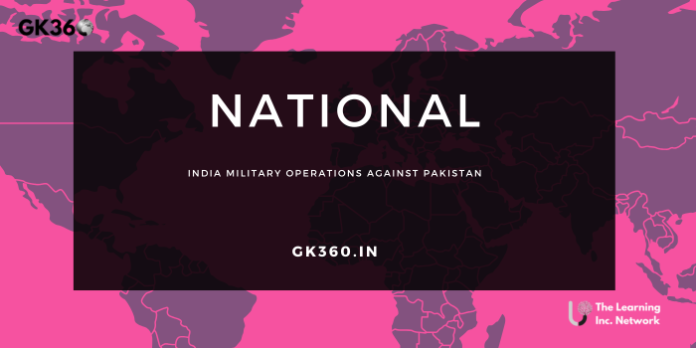India’s Military Operations Against Pakistan: Key Battles, Strategies & Strikes
Introduction: India-Pakistan Military Rivalry Across Decades
Since their independence in 1947, India and Pakistan have been locked in a persistent military rivalry, marked by a series of wars, conflicts, and cross-border operations. From the dusty plains of Punjab to the icy heights of Kargil and Siachen, the two nations have clashed over territory, ideology, and security.
Over the decades, India’s military strategy has transformed from conventional large-scale warfare to high-precision surgical strikes aimed at neutralizing threats without escalating into full-blown wars. Each military operation has shaped not only India’s defense doctrine but also the broader geopolitical dynamics of South Asia.
With increasing attention on counter-terrorism and territorial defense, especially following events like the 2016 surgical strikes and 2019 Balakot airstrike (Operation Bandar), it’s crucial to revisit the major military operations India has undertaken against Pakistan. This article explores India’s key military campaigns, evolving strategies, and their lasting impact on national and regional security.
Table of Contents
- India’s Military Conflicts with Pakistan: An Overview
- Major Military Operations Between India and Pakistan
- Comparing India’s Military Responses: Evolution of Strategy
- Impact on Regional & Global Security
- Challenges Faced by India’s Military
- FAQs About India’s Military Operations Against Pakistan
- Conclusion: Lessons from India’s Defense Strategy
India’s Military Conflicts with Pakistan: An Overview
The military rivalry between India and Pakistan spans more than seven decades, punctuated by four major wars and numerous skirmishes along the Line of Control (LoC). Each conflict has been influenced by territorial disputes, ideological divisions, and external geopolitical pressures.
From the first war over Jammu and Kashmir in 1947–48 to the latest cross-border strikes targeting terrorist infrastructure, India’s military engagements reflect a shift from defensive warfare to assertive, pre-emptive actions aimed at safeguarding national sovereignty and neutralizing asymmetric threats.
This overview sets the stage for understanding the key operations that have shaped India’s military trajectory vis-à-vis Pakistan.
Major Military Operations Between India and Pakistan
Operation Riddle (1965)
In response to Pakistan’s Operation Gibraltar and Operation Grand Slam, aimed at infiltrating Jammu and Kashmir, India launched Operation Riddle in September 1965. The goal: to strike key Pakistani cities like Lahore and Kasur and force Pakistan to divert its forces from Kashmir.
Key highlights of Operation Riddle:
- Indian troops advanced deep into Pakistani territory.
- Captured strategic areas near Lahore before a ceasefire was brokered.
- Led to a military stalemate formalized by the Tashkent Agreement (1966).
Impact: Operation Riddle showcased India’s willingness to shift from defensive postures to offensive counter-attacks deep inside enemy territory, setting a precedent for future strategic operations.
Operation Ablaze (1965)
Before the full-scale war broke out in 1965, India initiated Operation Ablaze — a precautionary mobilization of troops along the western border in anticipation of conflict following the Rann of Kutch skirmishes.
Key aspects:
- Massive troop deployments aimed at deterring Pakistani aggression.
- Established forward defensive positions along the international border.
Although Operation Ablaze didn’t lead to immediate combat, it played a critical role in India’s rapid readiness when war erupted months later. It reflected India’s early recognition of the need for preemptive military positioning.
Operation Cactus Lily (1971)
The 1971 Indo-Pak War, fought in the context of the Bangladesh Liberation War, saw India launch Operation Cactus Lily to support the Mukti Bahini and facilitate the liberation of East Pakistan.
Notable achievements:
- Indian forces executed a daring airlift across the Meghna River, bypassing Pakistani defenses.
- Swift advances toward Dhaka culminated in the surrender of 93,000 Pakistani troops.
- Paved the way for the creation of Bangladesh on December 16, 1971.
Operation Cactus Lily is celebrated as one of India’s most decisive military victories, combining ground, air, and naval power in a synchronized campaign.
Operation Trident (1971)
During the Indo-Pakistani War of 1971, the Indian Navy launched Operation Trident, a surprise naval offensive against Karachi Port on December 4, 1971. This marked India’s first use of anti-ship missiles in combat, revolutionizing naval warfare in the region.
Key outcomes:
- Destroyed Pakistani destroyers, minesweepers, and a fuel storage facility.
- Sank several Pakistani naval vessels, crippling maritime operations.
- Forced Pakistan to close Karachi Port for weeks.
Impact: Operation Trident was a game-changer for India’s naval power projection, establishing dominance in the Arabian Sea and commemorated annually as Indian Navy Day.
Operation Python (1971)
Two nights after Operation Trident, India executed Operation Python, a follow-up naval strike targeting Karachi to amplify the damage.
Key highlights:
- Indian Navy’s strike group launched missile attacks under cover of darkness.
- Destroyed additional oil storage tanks and ships at Karachi.
- Further weakened Pakistan’s naval and logistic infrastructure.
Together, Trident and Python paralyzed Pakistan’s maritime supply lines, contributing significantly to India’s swift victory in the 1971 war.
Operation Meghdoot (1984)
In April 1984, India launched Operation Meghdoot to preempt Pakistani occupation of the Siachen Glacier, the highest battlefield on earth.
Strategic importance:
- Indian troops secured key mountain passes and peaks before Pakistan could mobilize.
- Established permanent posts at altitudes over 20,000 feet.
- Ensured Indian control over Siachen Glacier, which remains contested to this day.
Impact: Operation Meghdoot demonstrated India’s logistical and operational capability in extreme high-altitude warfare, setting a precedent for future deployments.
Operation Vijay (1999)
The Kargil conflict of 1999 saw India launch Operation Vijay after Pakistani soldiers and militants occupied strategic heights along the Line of Control (LoC) in Kargil.
Operation milestones:
- Indian Army engaged in grueling high-altitude battles to recapture posts.
- Conducted assaults under intense enemy fire and challenging terrain.
- Fully evicted intruders by July 26, 1999 — now commemorated as Kargil Vijay Diwas.
Impact: Operation Vijay reaffirmed India’s commitment to safeguarding territorial integrity and showcased its military resilience in mountainous warfare.
Operation Safed Sagar (1999)
Simultaneous to Operation Vijay, the Indian Air Force launched Operation Safed Sagar, its first air campaign in Kashmir since 1971.
Key achievements:
- Precision airstrikes on enemy bunkers along rugged ridges.
- Employed laser-guided bombs and fighter jets at high altitudes.
- Provided close air support to ground troops.
Impact: Operation Safed Sagar underscored the synergy between India’s air and ground forces in modern warfare.
Surgical Strikes (2016)
On September 29, 2016, following the Uri terrorist attack that killed 19 Indian soldiers, India conducted surgical strikes across the LoC.
Operation highlights:
- Indian Army commandos destroyed terrorist launch pads in Pakistan-occupied Kashmir.
- Eliminated militants preparing for infiltration.
- Avoided civilian casualties while signaling a shift to proactive counter-terrorism measures.
Impact: The strikes marked India’s doctrinal evolution towards punitive retaliation and redefined India’s counter-terrorism policy.
Operation Bandar (2019)
After the Pulwama terror attack in February 2019, where 40 CRPF personnel were killed, India launched Operation Bandar (Balakot airstrike).
Key details:
- Indian Air Force crossed the LoC for the first time since 1971.
- Struck a Jaish-e-Mohammed terrorist training camp in Balakot, deep inside Pakistan.
- Escalated into brief aerial skirmishes between India and Pakistan.
Impact: Operation Bandar showcased India’s airstrike capability deep inside enemy territory, reaffirming its resolve to counter terrorism beyond borders.
Comparing India’s Military Responses: Evolution of Strategy
India’s military operations against Pakistan reveal a clear trajectory of strategic evolution:
| Era | Primary Strategy |
|---|---|
| 1947–1971 | Conventional wars for territorial disputes |
| 1980s | High-altitude defense (Siachen) and proactive deployments |
| 1990s | Hybrid warfare: counter-insurgency and conventional conflict (Kargil) |
| 2010s | Precision strikes & targeted operations (Surgical Strikes, Balakot) |
- ✅ Shift from large-scale mobilizations to targeted, high-precision strikes.
- ✅ Greater use of air power, special forces, and technological superiority.
Impact on Regional & Global Security
India’s military operations have:
- Deterred cross-border incursions and terrorism.
- Shaped South Asia’s security environment.
- Enhanced India’s standing as a responsible military power on the global stage.
- Fostered strategic partnerships with nations like the US, Israel, and France.
Challenges Faced by India’s Military
Despite successes, India faces ongoing challenges:
- Border Disputes: Continuing tensions in Kashmir and Ladakh.
- Resource Constraints: Balancing defense budgets with modernization goals.
- Technology Gaps: Need for indigenous defense tech to reduce import dependence.
- Multi-Front Threats: Simultaneous challenges from Pakistan and China.
- Internal Security Pressures: Counter-insurgency operations in sensitive regions.
FAQs About India’s Military Operations Against Pakistan
1. Why did India conduct surgical strikes in 2016?
👉 To retaliate against the Uri attack and eliminate terrorist launch pads across the LoC.
2. What was India’s biggest military victory over Pakistan?
👉 The 1971 Indo-Pak War, culminating in the creation of Bangladesh and the surrender of 93,000 Pakistani troops.
3. How did Operation Meghdoot impact India’s defense?
👉 It secured control of Siachen Glacier, giving India a strategic advantage in the world’s highest battlefield.
4. What was the objective of Operation Bandar?
👉 To destroy a Jaish-e-Mohammed terrorist camp in Balakot following the Pulwama terror attack.
5. How has India’s military strategy evolved over time?
👉 From conventional wars to precision strikes and proactive counter-terrorism measures.
Conclusion: Lessons from India’s Defense Strategy
India’s military operations against Pakistan showcase a journey of strategic adaptation, technological advancement, and assertive defense posturing. From the battlefields of Lahore to surgical strikes across the LoC, India’s military has evolved to meet asymmetric threats while maintaining conventional readiness.
As India continues to modernize its forces and strengthen strategic partnerships, these operations stand as milestones in safeguarding national sovereignty, deterring aggression, and ensuring regional stability.
Key Takeaways Table
| Aspect | Details |
| Military Rivalry | Ongoing since 1947; shaped by wars, skirmishes, and ideological conflict. |
| Landmark Victory | 1971 Indo-Pak War leading to Bangladesh’s creation; surrender of 93,000 troops. |
| Strategic Evolution | From conventional warfare to precision, pre-emptive strikes (2010s focus). |
| High-Altitude Warfare | Operation Meghdoot secured Siachen Glacier, world’s highest battlefield. |
| Counter-Terror Doctrine | 2016 Surgical Strikes & 2019 Balakot airstrike showcased proactive measures. |
| Naval Power Projection | Operation Trident & Python crippled Pakistan’s navy during 1971 war. |
| Modern Challenges | Facing multi-front threats, tech gaps, and budget-resource constraints. |





